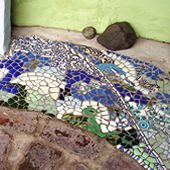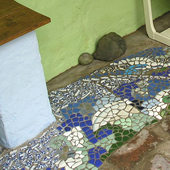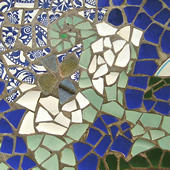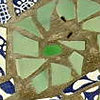It might happen in most households, or maybe it's just ours, but we seem to have ended up with a lot of broken pots.
Many end up being used as crocks for drainage in the bottom of plantpots. If they have sentimental value, broken bowls, plates and vases often end up in the 'things to mend' box/drawer/cupboard. (I know that it's not just me, and that many people have these, from all those 'house-decluttering' programmes on the TV.)
If the item was bought by someone close, maybe someone who is no longer around, the broken pieces take on a significance that seems to demand that we keep them.
So I had a bag full of broken pots. I had a vague idea of making a mosaic from them, but I didn't think I had the time or expertise to make one just for the sake of it, as a purely artistic project.
Then I realised I had a gap that a mosaic might fill perfectly, on the floor of Millennium Shed. Millennium Shed already has benches made from recycled breeze blocks and the old shed door, so using old pots on its floor seemed appropriate.
I hadn't realised, until I researched the subject on the internet, that using broken pots to make a mosaic effect is known as 'memory ware'. It was clear that other people have managed to make mosaics from broken crockery. Still, I set about my project with some trepidation.
Floor problems
Half of the floor of Millennium Shed is brick, as the paving kind of curves in to the front of it. The rest has been problematic over the years, as it was filled with loose materials - first limestone chippings, then slate chippings. Whatever kind of chippings, the local cats used it as a large cat litter tray. It needed changing, and I didn't want plain concrete filling up the gap. Continuing the brick would have been difficult, as the bench supports get in the way, and - perhaps more importantly - I didn't have any more bricks.
I researched on the internet whether you could use broken crockery to make a mosaic on a floor. It seemed that anything was possible in mosaicery, so I decided that the old broken things would be best used to liven up this problem floor area.
The mosaic making
I'd collected similar colours of broken pot together, the pieces in my favourite colours of blue and green. I thought that the mosaic might be too 'busy' and frantic if I used every colour available, so I decided to stick to these colours, plus white.
I had to bash the broken crockery into smaller pieces. Which, for health and safety purposes, I have to stress was undertaken while the crockery was wrapped in cloth (and eye protection is recommended).
When all the pottery was ready I mixed sand and cement mortar and trowelled it in to the space, and then had to work fast to get the pieces in. I decided against a plan of a design, as I just wanted this to be as easy a project as possible. The aims were clear - I wanted a) to reuse broken pots I couldn't bear to throw away and b) to make a solid floor for the rest of Millennium Shed.
So the pieces went in in a random fashion, pushed into the cement. I aimed for a vague representation of garden foliage and flowers. But the idea was so vague, and so soon abandoned as a general theme, that I doubt anyone looking at it could see this . . .
When it had begun to set and solidify I grouted it with a dry mix of the same sand and cement mix, and brushed it into the cracks and gaps between the ceramic parts.
The mosaic doesn't cover the whole area, and in the remaining area it is plain concrete. When the concrete was still setting, Rosie the cat chased a fly across the area, and left her pawprints indented in the area next to the mosaic. I could have smoothed the surface to hide them, but I didn't, as I thought that her contribution to the project was just as valid. It had just as much artistic merit as mine. Perhaps more so.
A year on
I didn't write about this project last year, when it was completed, as I had a fear it would disintegrate at the first sign of bad winter weather. It's now almost a year since it was done, and it's intact. When I look at it I can see plates, vases and bowls that remind me of other times in my life, other places I've lived, a holiday in Cornwall, friends and family. There's even pieces of the bowl we used as a water bowl for our cats - (the outside read "DOG" - but we assumed they couldn't read it.)
I realise that when other people look at it they don't see all these things, and probably have a different response - maybe not so sympathetic - like 'Why doesn't it go right up to the edges?'. Or indeed just 'Why?'.
Though it may have little artistic merit, it has a few substantial points in its favour - it isn't the colour of monotonous concrete, it reused something I could have thrown away, and the cats don't go to the toilet in it anymore. And that's good enough for me.
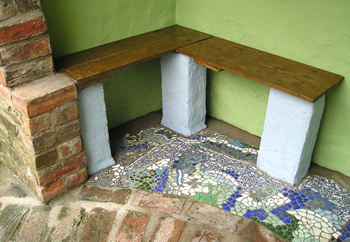
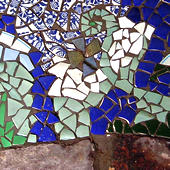
Above and below: the crockery mosaic on the floor of Millennium Shed
